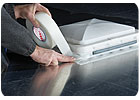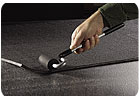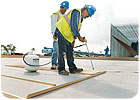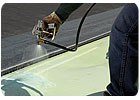
Making kitchen countertops by sticking Formica or other laminate to a wood substrate with contact cement may be the most familiar of all large-area bonding applications. The instant, durable adhesive bond was the perfect solution for contractors and consumers alike since Formica debuted in the 1920s.
Large-area bonding applications have grown considerably since then as designers recognized the performance, production and cost advantages of adhesives over other fastening techniques. This is particularly true in industries requiring faster, better or more stylish assemblies, such as transportation, aerospace, furniture and bedding.
Of course, what constitutes a “large area” is relative. It can encompass everything from fabric-covered wall panels and multilayer foam mattresses to smaller applications, such as gaskets, nameplates and automotive trim.
Joining high-pressure laminates, foam, fabric, rubber, film, cardboard, paper and other materials to metal, wood, plastics, glass or ceramic usually involves completely covering one or both surfaces with a thin, uniform coating of adhesive.
Adhesives for bonding large areas are considered nonstructural. Their bond strengths are typically less than 1,000 psi. They can be formulated to allow repositioning-useful where adjustments may be needed-or to provide high initial tack and bond strength greater than the substrate, which eliminates the need for jigs and holding time.
Here’s a look at the most common adhesives for bonding large areas.

To join foam, fabric, rubber and other materials to another substrate, one or both surfaces must be completely covered with a thin, uniform coating of adhesive.
Contact Adhesives
Contact adhesives are applied to both mating surfaces and allowed to dry. When the surfaces are pressed together, a strong bond forms immediately. Available in solvent- or water-based formulations, contact adhesives have a range of bonding strengths, curing times, viscosities and solids content. Many formulations meet military and other government specifications.Solvent-based nitrile rubber products with solids content of 18 percent to 25 percent can be brushed, rolled or sprayed. They achieve maximum shear strength of 480 to 540 psi in less than 30 minutes. Bonds resist heat, creep and continuous load stresses.
While solvent-based formulas dry quickly, there are health, safety and environmental concerns with their use. Some solvents, such as n-propyl bromide and methylene chloride, are controlled substances, which require extra time and work to manage. OSHA, EPA and many local and regional regulations mandate reduced solvent use in some areas, all but rendering solvent-based contact adhesives obsolete.
This has increased the popularity and availability of water-based contact adhesives using latex or neoprene rubbers. These formulations have similar performance specifications to solvent-based products, but are more environmentally friendly and safer for workers.
Water-based systems are not new-3M introduced Fastbond Contact Adhesive 30NF more than 40 years ago. It complies with California’s stringent South Coast Air Quality Management District Rule 1168 for contact adhesives. Formulations like 30NF have about twice the solids content of solvent-based adhesives. As a result, they provide up to 3.5 times more adhesive coverage, so they’re more economical, too. Its shear strength of 480 psi exceeds that of many solvent-based adhesives.
Because water-based adhesives are nonflammable in their wet state, fireproof cabinets are not needed for storage. There is no solvent odor, and that means healthier, more productive workers. These adhesives can be applied with a brush, roller or spray gun, including low-maintenance, gravity-feed models. Fans and heat accelerate drying.
To overcome slower dry times for water-based products, newer two-part formulations create quick initial tack so mated surfaces have the strength to be handled, increasing throughput. Two-part adhesives require special spray equipment: a double-nozzle, low-pressure spray gun that mixes the two-part adhesive outside the nozzle to avoid plugging. These adhesives can also be activated by heat for even faster curing. These adhesives produce shear strengths of 350 psi.
Another option is one-part, water-based neoprene contact adhesives. These fast-tacking adhesives strongly bond foam to foam in 15 seconds-or on contact if an activator is used. The foam will fail before the adhesive bond line. Neoprene adhesives have better heat resistance than water-based latex adhesives and conventional nonflammable and flammable foam adhesives. They have excellent resistance to aging, rapid strength buildup, a long bonding range, and good resistance to water and chemicals. This formulation bonds foam, fiber fill, fabric, leather and other substrates.

Water-based contact adhesives perform similarly to solvent-based products, but are more environmentally friendly and safer for workers.
Aerosol Adhesives
Generally based on latex and neoprene adhesives, aerosols are similar to contact adhesives, but most are formulated for applications requiring less strength and the ability to be repositioned. They are used for bonding lightweight materials, including fabrics, plastics, flexible foams, paper, cardboard and thin-gauge metals. They are available in handy aerosol cans, although for larger applications pressurized cylinders of various sizes provide easily managed, self-contained spray systems. Water-based aerosols are not yet available.Aerosol adhesives are formulated with a range of tack and bonding properties. Some have very aggressive tack, yet permit materials to be repositioned. Others create immediate one-surface bonds, while others have fast, aggressive tack with low soak-in for long-lasting bonds with many lightweight materials. Some adhere specifically to hard-to-bond, low-surface-energy plastics, such as polyethylene film. Others bond expanded or extruded polystyrene insulation without degrading the foam. A plasticizer-resistant aerosol bonds vinyl, leather and all types of rubber except EPDM. Another one-surface, pressure-sensitive spray formulation provides tape-like instant adhesion to hold foam in place for shipping containers or for permanently bonding insulation in heating and air-conditioning systems, appliances and walk-in coolers.

Adhesives for bonding large areas can be formulated to allow repositioning or to provide high initial tack and bond strength, which eliminates the need for jigs.
Sprayable Hot-Melt Adhesives
Hot-melt adhesives are one-part, 100 percent thermoplastic resins that flow when heated so they can be sprayed for large-area bonding applications. Applied to one or both surfaces, the sprayed material cools, hardens and reaches ultimate bond strength in seconds. Hot-melts are not for heavy-duty applications and are generally used for bonding lightweight substrates that will not be exposed to high-temperature environments. However, hot-melts are an alternative to some solvent-based adhesives for quickly bonding many materials.Hot-melt adhesives are available in low-melt and hot-melt formulations. Engineers should choose the melt temperature based on the materials to be glued (higher temperatures may be undesirable for some materials) and the bond strength desired (higher melt temperature adhesives have better heat resistance).
Low-melt formulations liquefy between 250 to 270 F. Usually applied by hand, rather than sprayed, low-melt formulations are reserved for bonding smaller parts and perimeter sealing, where 100 percent coverage is not required. Hot-tack, delayed-tack and removable low-melts are available in clear and colored formulations. Shear strength ranges from 350 to 600 psi on Douglas fir at 72 F. Peel strength ranges from 6 to 13 pounds per inch width on canvas at 72 F. Failure temperatures range from 120 to 140 F.
Hot-melt formulations liquefy between 350 to 385 F. These adhesives have higher heat resistance, the ability to bond low-surface-energy plastics, good environmental and electrical resistance, low viscosity for high flow rates and increased production, and excellent hot-tack, quick-grab and fast-setting properties. Shear strength ranges from 250 to 700 psi on Douglas fir at 72 F. Peel strength ranges from 6 to 29 pounds per inch width on canvas at 72 F. Failure temperatures range from 125 to 300 F.
There are hot-melt adhesives to bond virtually any substrate, including wood, thin metal, glass, ceramic, vinyl, leather, polyolefin, plastic, paper, coated and uncoated cardboard, fabric, and rigid and flexible foam. Special hot-melt spray equipment is required for application.
Sealants
Sealants are high-solids (90 percent), viscous adhesives that solidify once applied. These flexible materials adhere to substrates and prevent the intrusion of air, gas, ultraviolet light, dust, smoke, fire, and liquid through the joint. They must resist water, solvents, fuel, temperature extremes and corrosion. Sealants fall between high-strength adhesives and extremely low-strength putties and caulks. Because sealants provide an environmental barrier for assemblies and joints, they are formulated with elastomeric properties for adequate flexibility and elongation without shrinkage to remain bonded over the expected life of an assembly.Sealants can be one-part polyurethanes, acrylics, polysulfides and butyl rubbers. They vary in consistency from heavy liquids and pastes to mastics.
Thin Bonding Tapes
Tapes have pressure-sensitive adhesive on two sides to bond mating surfaces with strengths that range from repositionable to permanent. Conformable foam tapes, removable and repositionable tapes, and adhesive transfer tapes provide toughness and durability for applications that demand strength, flexibility and resistance to harsh environments. The adhesives are acrylic formulations that adhere instantly to a specific material or a broad range of materials-from aluminum and steel to hard-to-bond plastics and powder coatings.For large-area applications, peel-and-stick adhesive tapes can be die-cut to precisely fit any shape, size, or profile. Pressure-sensitive adhesives bond parts instantly, eliminating the need for fixtures or long cure times. Because of their viscoelasticity, tape adhesives absorb shock and flexing, and they resist fatigue caused by wind, vibration and thermal cycling. Many tapes can withstand temperatures as high as 450 F. For example, peel-and-stick adhesive, die-cut for a perfect fit, has replaced fasteners to join heat shielding panels inside the engine hoods of popular military all-terrain vehicles.
Thin tapes are used for large-area bonding in electronic, transportation, aerospace, medical, architectural and industrial applications.
Advanced adhesive formulations and application methods are enlarging the performance envelope for large-area bonding applications. They can accommodate a wider range of temperatures, withstand greater physical stresses, tolerate more challenging environmental conditions, and comply with more stringent production health and safety requirements. Designers have more adhesive options than ever.
Large-Area Bonding Applications
Contact AdhesivesBond laminates to countertops and tabletops
Assemble cabinets (particle board, plywood, plastic laminate)
Assemble compound cushions (foam to substrate)
Assemble furniture (foam, fiber fill, fabric)
Assemble mattresses and bedding (foam to foam, quilted fabric to solid core)
Attach carpet to fiberglass flooring (boats)
Adhere insulation inside metal doors, wall panels, and refrigerators
Bond rubber to metal flooring (buses, trains) and headliners (boats)
Bond fabric to drywall
Attach foam insulation to concrete
Bond felt to wood (audio speakers)
Bond flexible urethane and latex foams to themselves
Bond fabric to metal, wood or plastic office partitions
Aerosol Adhesives
Join hard-to-bond plastics (polypropylene film, foam)
Bond foam and fabric
Temporarily hold badges during stitching or T-shirts during screening
Permanently attach carpet, nameplates, pool liners, pipe insulation
Attach paper-backed fiberglass insulation, thin decorative films, foils
Bond expanded or extruded polystyrene and other insulation
Bond rubber, vinyl, leather, metal panels, kick plates
Form high-strength bonds for decorative laminates and signage
Seal cardboard cartons
Hold palletized plastic bags in place for shipping
Hot-Melt Adhesives
Attach headliners in specialty vehicles and boats
Assemble point-of-purchase displays and trade show exhibits
Assemble nameplates, luggage, speaker fabric and protective metal grills
Assemble novelties, toys, games and costumes
Sealants
Fill and seal gaps in boat cabin roof panels
Seal marine rigging, hardware and fittings above and below the waterline
Seal seams and gaps in HVAC systems
Hold carpeting in place
Affix shower and tub enclosures to drywall
Thin Bonding Tapes
Assemble electronics, including GPS units, cell phones, flat-screen TVs and marine equipment
Bond automotive interior and exterior trim pieces, headliners, under-hood insulation, commercial vehicle signage
Attach stainless steel anti-chafing strips to aluminum wing flaps on commercial jets
Bond exterior building skin panels, architectural signage and traffic signs
Attach nameplates on industrial equipment